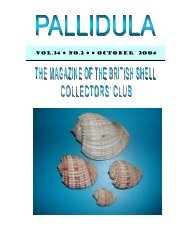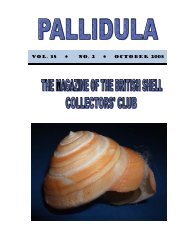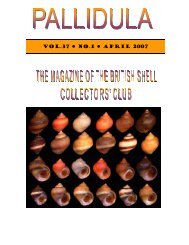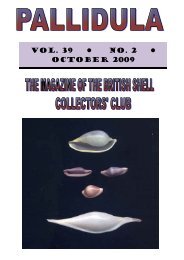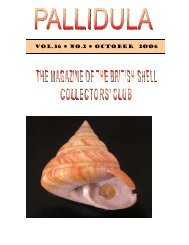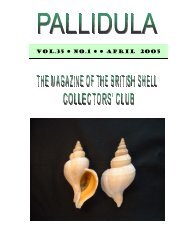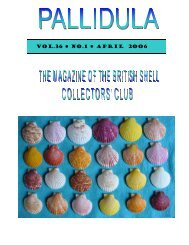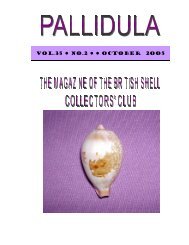April, 2004 - British Shell Collectors' Club
April, 2004 - British Shell Collectors' Club
April, 2004 - British Shell Collectors' Club
You also want an ePaper? Increase the reach of your titles
YUMPU automatically turns print PDFs into web optimized ePapers that Google loves.
Page 12PALLIDULA<strong>Shell</strong>ing in Cumbria October 2003By Selina WilkinsI was sent on business to Barrow in Furness, and was delighted to find it marked on the map withgolden sands. I booked into a delightful small hotel that is also a pub, with excellent breakfast andevening meals called Clarke’s Hotel, at Rampside. Although on arrival it was raining, I put on myraincoat and ambled down to the beach, it might never have stopped raining. On first perusal Idiscovered hoards of cockles, Cerastoderma edule, and beautiful Macoma balthica. The Macomabalthica were pink, dark pink, pale pink, yellow, cream, white, peach and all with both valvespreserved and intact. They were mostly juveniles, but to have them intact, with such colour variation– I was very happy. I was also pleased to find a few Turritella communis, as the beaches I go torarely have them, and I also found one specimen of a little un-yet identified gastropod.At Whaley Island I found nothing at the beach, but it was raining, and I didn’t have a pair of wellies toinvestigate slippery stones and seaweed. So I chose on my remaining days to concentrate onFoulney Island and Rampside Beach.For the next three days after work I explored the area. Rampside Beach was very good for beachedspecimens of bivalves and gastropods, especially the Macoma balthica and Littorina genus. To thefar right of the beach there was an area of rocks with more gastropods and the Mytilis edulis and theoysters.Foulney Island was a lovely walk out along a causeway. This is where the beached gastropods andMytilis edulis mainly came from. Beyond the cement block on the right hand side (as recommendedfor baiters) there were stones strewn with seaweed. Littorina obtusata could be found movingamongst the seaweed, and the Mytilis edulis was between the rocks and stones. The Nucella lapilluspreferred the exposed rocks and stones, and Littorina littorea and saxitilis could be found whereverthere was moisture, but also in the seaweed.It was a very picturesque place and those of you into bird watching as well would have appreciatedthe oystercatchers, redshank, sanderlings, dunlins, curlews and whimbrels, various gull species. Inthe summer there are nesting eiders, sandwich and little terns as well as common terns. It might notseem a shelling Mecca to some of you, but I found the place delightful, relaxing and the food atClarke’s hotel was wonderful (the Moules marniere come all the way from Chile!)Rampside BeachFoulney IslandCerastoderma edule Linnaeus, 1758 Littorina littorea Linnaeus, 1758Ostrea edulis Linnaeus, 1758 Mytilis edulis Linnaeus, 1758Crassostrea virginica Gmelin, 1791 Nucella lapillus Linnaeus, 1758Mytilis edulis Linnaeus, 1758 Littorina obtusata Linnaeus, 1758Macoma balthica Linnaeus, 1758 Buccinum undatum Linnaeus, 1758Littorina obtusata Linnaeus, 1758Littorina saxatilis Olivi, 1792Littorina littorea Linnaeus, 1758Ocenebra erinacea Linnaeus, 1758Turritella communis Linnaeus, 1758Nucella lapillus Linnaeus, 1758Chlamys varia Linnaeus, 1758Buccinum undatum Linnaeus, 1758



